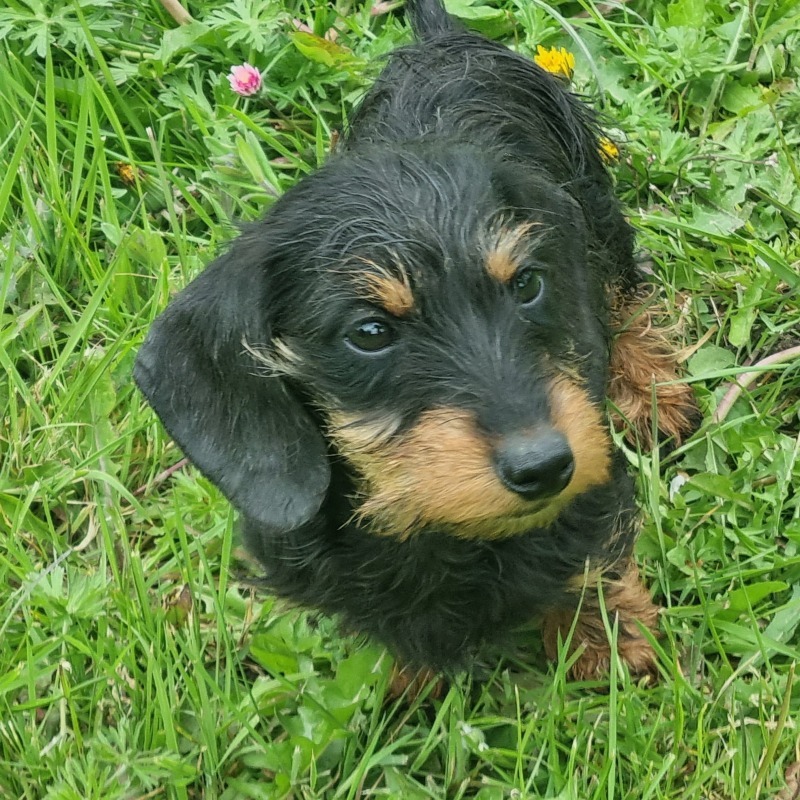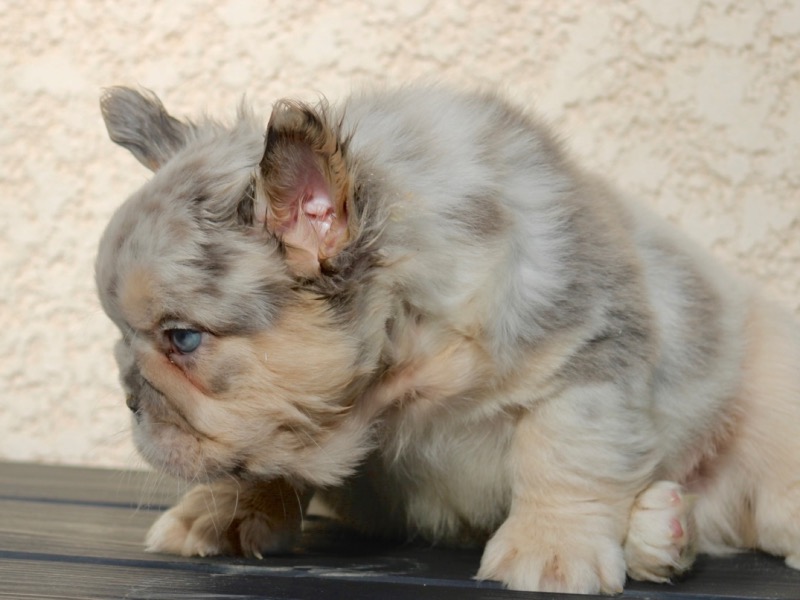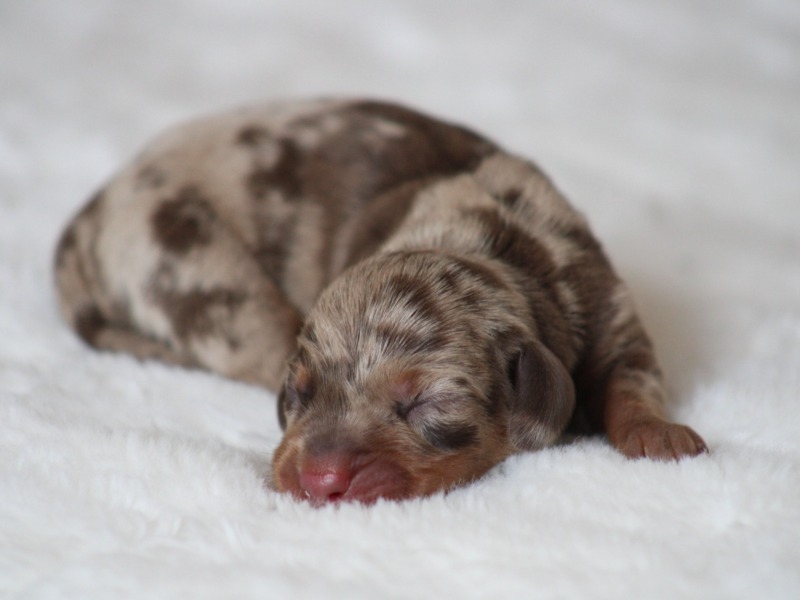Dachshund
Welcome to our page dedicated to the breed of dog dachshund!
Here, you will find all the useful information about dachshund. This descriptive profile will allow you to discover the aspects of this breed. You can notably consult information about the average price, monthly and annual upkeep expenses, their health, name ideas, as well as their official recognition by competent authorities.
Explore this page to discover everything you need to know.
Overall description of the breed
This is a very ancient breed, with the first specimens resembling Dachshunds observed since the Middle Ages, accompanying us through the centuries. All varieties of Dachshunds originate from Bavaria, Germany.
Some experts assert that it could be one of the many descendants of an ancestral breed, the German Basset. This efficient partner is particularly favored by hunters, notably for its agility and ability to slip into burrows, thanks to its elongated body shape and the power of its small legs. This small working dog demonstrates remarkable willingness, attentiveness to its environment, and activity. It also finds its place in hunting parties or fox hunts.
There are three distinct coat varieties: smooth, medium-length, and long, all listed in the breed standard. The Dachshund remains widely appreciated in the West and still holds a special place in the hearts of Anglo-Saxons, especially as a pet.
In Germany, the first official Dachshund club opened its doors in 1888, but it took over 70 years for the International Canine Federation to officially register it on January 1, 1955. A recent update of the standard was published on May 25, 2021.
The Dachshund belongs to the category of small dogs, but don't be deceived by its measurements; its build is robust, and its endurance is considerable. One of its distinctive characteristics is its physical appearance—its elongated body shape has earned it the nickname "sausage dog" or "hot dog," being much longer than it is tall, forming a rectangular shape.
Its musculature is developed but not excessive, with broad shoulders and sturdy lower limbs. Its topline is slightly curved towards the back, revealing firm and vigorous hindquarters. Its head, much like its body, is elongated in appearance, deep, and narrow, coupled with a lengthened muzzle from the top and side view, tapering regularly to the nose without being pointed.
Its ears are set high and not too far forward, always long but without exaggeration. Its tail is well placed, not too high, and carried in line with the back, descending alongside the thigh to the hock. In the three Dachshund breed standards, a multitude of colors exist, ranging from classic shades like black, red, and cream to more original options like tricolor or harlequin.
In the vast majority of cases, the Dachshund is described as an endearing, joyful, and very close companion to its owners. However, we do notice a more assertive temperament in the wire-haired variety, yet most Dachshunds remain obedient and pleasant dogs to live with on a daily basis.
Versatile, it is a formidable tracker, willing and efficient in hunting. This brave little dog demonstrates exemplary courage in its work. Dynamic in its missions of hunting small and medium game, it also remains a gentle and affectionate family pet. Never fearful nor aggressive, contact with humans is essential to its well-being.
It is a confident companion that can stay alone for several hours without excessive anxiety. Its balanced character allows it to adapt to all lifestyles, whether living in the city or the countryside. It is always content in the company of its loved ones. Of course, the numerous qualities of the Dachshund do not exempt it from early and positive training, which is necessary for the well-being of this devoted and extremely endearing small dog.
Contrary to other dogs, the measurements of the Dachshund are determined based on its chest circumference:
- Standard Dachshund: Chest Circumference: Males: over 37 up to 47 cm (14.5" to 18.5") - Females: over 35 up to 45 cm (13.7" to 17.7")
- Miniature Dachshund: Chest Circumference: Males: over 32 up to 37 cm (12.5" to 14.5") - Females: over 30 up to 35 cm (11.8" to 13.7")
- Kaninchen Dachshund: Chest Circumference: Males: 27 cm up to 32 cm (10.6" to 12.5") - Females: 25 cm up to 30 cm (9.8" to 11.8")
Its adult weight ranges between 3 and 9 kg (6.6 to 19.8 lb), and its height is between 15 and 25 cm (5.9" to 9.8") at the withers.
Awareness of acquiring an animal
Each animal is a sensitive being, deserving love, attention and care.
When you choose to adopt an animal, you take on the responsibility of ensuring its health and well-being throughout its life.
To learn more about animal welfare, we invite you to consult our FAQ by clicking the button below:
Origins
The dachshund, also known as a teckel, originates from Germany. It was developed from hunting dogs for their ability to pursue game in burrows. Its name comes from the German "Dachs" meaning badger, and "Hund" for dog, indicating its initial role as a badger hunter. The breed was perfected to have a long body and short legs, facilitating entry into burrows. The first mentions of dogs resembling dachshunds date back to the Middle Ages, but it was in the 19th century that the dachshund began to look like what we know today. The popularity of this dog quickly spread beyond Germany, particularly in England and America, where they were bred not only for hunting but also as faithful companions.
History
The Dachshund has a rich history related to hunting in Europe. In the 17th century, it was already known in Germany for its bravery and efficiency in hunting badgers and foxes. Its unique physique, with a long body and short legs, made it ideal for this task. In the 19th century, German breeders began to standardize the breed, leading to the official recognition of the Dachshund as a distinct breed. Dachshunds were introduced to England in the mid-19th century, where they quickly gained popularity. In the United States, the breed was recognized by the American Kennel Club (AKC) in 1885. Today, the Dachshund is appreciated both for its hunting qualities and for its affectionate nature and distinctive appearance, making it a beloved companion worldwide.
Standard
The dachshund breed standard varies slightly between organizations, but common characteristics are observed. The dachshund should have a long and low body, a strong spine, and short, sturdy legs. The head is elongated with drooping ears, expressive and lively eyes, and a strong jaw. The tail is carried in line with the back. The dachshund comes in three coat varieties: smooth, long, and wire-haired, and in several sizes, with the main ones being standard, miniature, and kaninchen. Accepted colors include black and tan, chocolate, red, cream, and brindle. Each variety and size has its own specific details detailed in national and international canine club standards.
Physical characteristics
The dachshund comes in three sizes: standard, miniature, and kaninchen (very small). Standard dachshunds weigh between 7 and 14 kg and measure about 20-27 cm at the withers. Miniatures weigh up to 5 kg with a height of 12-15 cm. Kaninchens, the smallest, weigh less than 4 kg. In terms of coat, there are three varieties: short, smooth, and shiny coat; long, silky, and wavy coat; and wire-haired, with a rougher texture and a distinctive beard. Dachshund colors can vary, including black and tan, chocolate, red, brindle, and cream. Their elongated body and short legs are distinctive features, as well as their elongated head and drooping ears.
Character
The dachshund is known for its lively, intelligent, and courageous character. These dogs are often very curious and have a well-developed hunting instinct, which can sometimes make them stubborn and independent. They are also very loyal and affectionate towards their family, forming close bonds with their owners. Despite their small size, dachshunds can be quite bold and do not easily back down from a challenge, a trait inherited from their badger-hunting ancestors. They can be wary of strangers, but when socialized well, they become joyful and friendly companions. Their sometimes obstinate nature requires firm but gentle training to properly channel it.
Life expectancy
Dachshunds generally enjoy a long lifespan for a breed of their size, living between 12 and 16 years, or even more with proper care. Their longevity can be attributed to a sturdy constitution and a genetic predisposition to health. However, to maximize their lifespan, it is crucial to monitor their weight and prevent back problems, common in this breed due to their elongated spine. Regular visits to the veterinarian, a balanced diet, and moderate exercise also contribute to their long-term well-being. Well-maintained Dachshunds can live a full and active life well into old age.
Exercise and activity needs
Despite their small size, Dachshunds have a moderate to high level of energy and require an adequate amount of daily exercise. A daily walk of 30 to 60 minutes, combined with play sessions, is essential to maintain their physical and mental health. These dogs also enjoy exploring and sniffing, a legacy from their hunting past. Interactive games and puzzle toys can help stimulate their sharp minds. However, it is important to be careful not to overload their spines, avoiding excessive jumping and stairs. Regular exercise helps prevent obesity, which can worsen back problems and other health issues in Dachshunds.
Recommended diet
Dachshunds need a balanced and high-quality diet adapted to their size and activity level. It is recommended to feed an adult dachshund with premium kibble, high in protein and low in fat, to avoid obesity. Portions should be controlled, and it is advisable to divide meals into two portions per day. The monthly cost of feeding a dachshund ranges between 30 and 60 euros, depending on the quality of the chosen food. Healthy treats can be given in moderation. It is crucial to avoid high-fat and high-calorie foods to prevent excess weight, which can lead to health problems such as joint issues and heart disorders.
Training and obedience
Dachshunds' education and training require patience and consistency due to their sometimes stubborn nature. Starting training at a young age is essential to establish good habits. The use of positive reinforcement techniques, such as rewards and praise, is particularly effective. Dachshunds respond well to consistent and regular training, with short and varied sessions to maintain their interest. It is also important to socialize dachshunds from a young age, exposing them to various situations, people, and other animals. Their intelligence and natural curiosity can be channeled through interactive games and obedience activities, reinforcing their behavior and bond with their owner.
Behavior with children
Dachshunds can be excellent companions for children when properly socialized and trained. They are usually affectionate and playful, enjoying interactions with the young family members. However, due to their small size and unique body structure, it is crucial to teach children to handle Dachshunds gently to prevent injuries, especially to the back. Supervision of interactions between children and dogs is always recommended to prevent any accidental incidents. With proper introduction and mutual respect, Dachshunds can become loyal and protective companions for children, sharing games and snuggles daily.
Compatibility with Other Animals
Dachshunds can get along with other pets, especially if raised together from a young age. However, their natural hunting instinct can sometimes make them wary or aggressive towards small animals like rodents or birds. Early and ongoing socialization is essential to promote harmonious cohabitation with other dogs and cats. In general, dachshunds who have been properly socialized and trained can learn to peacefully coexist with other animals, although initial supervision is recommended. Each dachshund has its own personality, and some may be more tolerant and friendly towards their animal companions than others.
Grooming needs
The grooming needs of dachshunds vary depending on the type of coat. Dachshunds with short hair require weekly brushing to remove dead hair and keep their coat smooth and shiny. Dachshunds with long hair require more frequent brushing, at least two to three times a week, to prevent matting. Dachshunds with wire hair need regular grooming, including hand stripping several times a year to maintain the texture of their coat. All dachshunds require regular dental hygiene, nail trimming, and ear cleaning to prevent infections. An occasional bath with a mild shampoo is sufficient to keep them clean.
Health
Dachshunds are generally sturdy, but they can be prone to certain health conditions. Back problems, especially disc hernias, are common due to their elongated spine. Obesity can worsen these issues, so maintaining a healthy weight is essential. Dachshunds can also suffer from heart disease, diabetes, and dental problems. Regular veterinary monitoring, balanced nutrition, and moderate exercise are crucial in preventing these conditions. Some Dachshunds may be predisposed to Cushing's disease, ear infections, and eye problems such as cataracts. Early screening and proper veterinary care can help manage and prevent these health issues.
Average price
The average price of a Dachshund can vary considerably depending on the lineage, breeder reputation, coat type, and size. Generally, the cost of a purebred Dachshund with papers can range from 800 to 2,000 euros. Dachshunds from champion lines or with exceptional pedigrees may cost even more. It is important to choose a reputable breeder who conducts health tests and offers a health guarantee for their puppies. In addition to the initial purchase price, prospective owners should also budget for ongoing costs related to food, veterinary care, health insurance, and accessories for their new companion.
Expenses
Monthly expenses for a Dachshund can vary depending on the specific needs of the dog and the preferences of the owners. On average, monthly costs include food (30-60 euros), routine veterinary care including vaccines and deworming (10-20 euros), grooming products (5-10 euros), and accessories such as toys and treats (10-20 euros). Costs may increase if the dog requires additional veterinary care or treatments for specific health conditions. Owners may also choose to take out pet health insurance, which can add between 20 and 50 euros per month. Overall, monthly expenses for a Dachshund can range from 75 to 160 euros.
Name ideas
Choosing a name for a dachshund can be a fun and meaningful task. Here are some ideas for names that suit this energetic and adorable breed: Max, Bella, Oscar, Daisy, Milo, Luna, Bruno, Ruby, Charlie, Molly, Leo, Sophie, Rex, Lily, Toby, Lucy, Jack, Sadie, Rocky, and Rosie. When selecting a name, it is often helpful to choose something short and easy to pronounce, which will make it easier for the dog to recognize the name. A name that reflects the dachshund's unique personality or has personal meaning to the owner can also be an excellent option.
Legislation and regulation
In France, dachshunds are not classified in the categories of dangerous dogs and do not have specific restrictions related to their possession. However, owners must comply with general regulations regarding dogs, such as mandatory identification by microchip or tattoo, and registration with the ICAD (Identification of Domestic Carnivores). Dachshunds must also be regularly vaccinated and dewormed. In other countries, regulations may vary, but generally, dachshunds are not subject to specific restrictions due to their non-aggressive nature. Owners should inquire about local requirements regarding the registration and care of their pet.
Official recognition
The dachshund is recognized by many canine organizations worldwide. In France, it is recognized by the Société Centrale Canine (SCC). In the United States, the American Kennel Club (AKC) recognizes the dachshund, as does the Kennel Club (KC) in the United Kingdom. Other organizations such as the Fédération Cynologique Internationale (FCI) and the Canadian Kennel Club (CKC) also recognize this breed. These organizations establish breed standards and organize competitions and events for dachshunds. Official recognition ensures that dachshunds meet specific criteria for conformation, temperament, and health, helping to maintain the quality and distinctive characteristics of the breed.
Pedigrees
Several breed clubs around the world offer pedigrees for Dachshunds. In France, the Club des Amateurs de Teckels (CAT) is a reference for enthusiasts and breeders. In the United States, the Dachshund Club of America (DCA) plays a similar role, as does the Dachshund Club of the United Kingdom (DCUK) in Britain. In Germany, the Deutscher Teckelklub (DTK) is one of the oldest and most respected breed clubs. These breed clubs not only offer pedigrees but also resources for breeding, health, and well-being of Dachshunds. They also organize dog shows and events to promote the breed and educate owners.
Destination and usage
Historically, dachshunds were bred for badger and fox hunting, thanks to their long body and short legs adapted for chasing prey in burrows. Today, though some dachshunds are still used for hunting, most are beloved pets cherished for their affectionate nature and energy. Their compact size and adaptability make them excellent companions for urban and rural households. Dachshunds are also active in canine sports such as agility, tracking, and conformation competitions. Their loyal and curious nature makes them well-suited for participating in a variety of activities, strengthening their bond with their owners.
Prohibitions
Dachshunds are not generally subject to specific prohibitions on ownership or breeding, unlike some breeds classified as dangerous. However, it is forbidden to use dachshunds for dog fights or any other illegal and cruel activity towards animals. Local regulations may also include restrictions on the sale of puppies, requiring breeders to adhere to high welfare standards. It is crucial to check local and national laws concerning the ownership and breeding of dachshunds to ensure compliance and animal welfare. In general, dachshunds have a good reputation and are not subject to strict bans.
Breeders of Dachshund
Want to see more breeders of Dachshund?
Check out the page of our directory listing all breeders of DachshundClassified Ads of Dachshund
Breed clubs of dachshund
No of dachshund breed clubs are currently registered on Preeders.
If you would like to highlight your breed club, sign up for free now and be the first to appear on this page.






